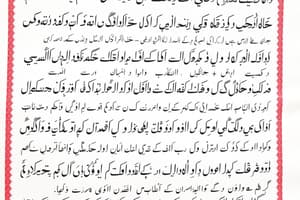Podcast
Questions and Answers
What is the writing direction of Urdu?
What is the writing direction of Urdu?
- Diagonal
- Vertical
- Left to right
- Right to left (correct)
Which of the following is NOT a recognized dialect of Urdu?
Which of the following is NOT a recognized dialect of Urdu?
- Dakhini
- Other regional dialects
- Rekhta
- Bengali (correct)
What does the SOV structure in Urdu grammar represent?
What does the SOV structure in Urdu grammar represent?
- Object-Subject-Verb
- Subject-Verb-Object
- Subject-Object-Verb (correct)
- Sentence-Object-Verb
Which notable form of literature is prominently associated with Urdu?
Which notable form of literature is prominently associated with Urdu?
How many letters are in the Urdu alphabet?
How many letters are in the Urdu alphabet?
Flashcards are hidden until you start studying
Study Notes
Overview of Urdu
- Language Family: Indo-Aryan, part of the larger Indo-European family.
- Official Status: National language of Pakistan, recognized in India, and spoken by significant communities worldwide.
Script and Writing
- Script: Written in a modified form of the Persian script (Nastaʿlīq).
- Direction: Right to left.
- Alphabet: Contains 38 letters, including additional characters for sounds not found in Arabic and Persian.
Linguistic Features
- Vocabulary: Rich in loanwords from Persian, Arabic, Sanskrit, and Turkish.
- Dialects: Includes various regional dialects such as Dakhini, Rekhta, and others.
- Grammar:
- SOV (Subject-Object-Verb) word order.
- Gendered nouns and verbs.
- Cases include nominative, accusative, and oblique.
Cultural Significance
- Literature: Renowned for poetry and prose, significant figures include Ghalib, Iqbal, and Faiz Ahmed Faiz.
- Genres: Poetry forms such as Ghazal, Nazm, and Qawwali lyrics.
- Theater and Films: Urdu is prevalent in Pakistani cinema and Indian Bollywood films.
Usage and Statistics
- Speakers: Approximately 170 million native speakers, with many more fluent as a second language.
- Geographical Spread: Predominantly in Pakistan and India, with communities in the UK, USA, Canada, and the Middle East.
Education and Promotion
- Schools: Urdu is taught in schools in Pakistan and various Indian states.
- Media: Broadcasted through television, radio, online platforms, and print media.
Challenges
- Literacy: Varying literacy rates in different regions.
- Dialect Preservation: Modernization and urbanization leading to the loss of certain dialects.
Conclusion
- Urdu serves as a vital cultural and linguistic bridge in South Asia, embodying a rich literary tradition and vibrant modern expression.
Urdu: A South Asian Language
- Origin: Indo-Aryan language, part of the larger Indo-European family
- Official Status: National language of Pakistan, recognized in India, and spoken by significant communities worldwide.
- Script: Modified Persian script (Nastaʿlīq)
- Writing Direction: Right to left
- Alphabet: 38 letters, including additional characters for sounds not found in Arabic and Persian
- Vocabulary: Rich in loanwords from Persian, Arabic, Sanskrit, and Turkish
- Dialects: Includes various regional dialects such as Dakhini, Rekhta, and others
- Grammar:
- SOV (Subject-Object-Verb) word order
- Gendered nouns and verbs
- Cases include nominative, accusative, and oblique.
- Literature: Renowned for poetry and prose, significant figures include Ghalib, Iqbal, and Faiz Ahmed Faiz
- Genres: Poetry forms such as Ghazal, Nazm, and Qawwali lyrics
- Theater and Films: Prevalent in Pakistani cinema and Indian Bollywood films
- Speakers: Approximately 170 million native speakers, with many more fluent as a second language
- Geographical Spread: Predominantly in Pakistan and India, with communities in the UK, USA, Canada, and the Middle East
- Education: Taught in schools in Pakistan and various Indian states
- Media: Broadcasted through television, radio, online platforms, and print media
- Challenges:
- Varying literacy rates in different regions
- Dialect preservation due to modernization and urbanization
- Cultural Significance: Serves as a vital cultural and linguistic bridge in South Asia, embodying a rich literary tradition and vibrant modern expression.
Studying That Suits You
Use AI to generate personalized quizzes and flashcards to suit your learning preferences.




